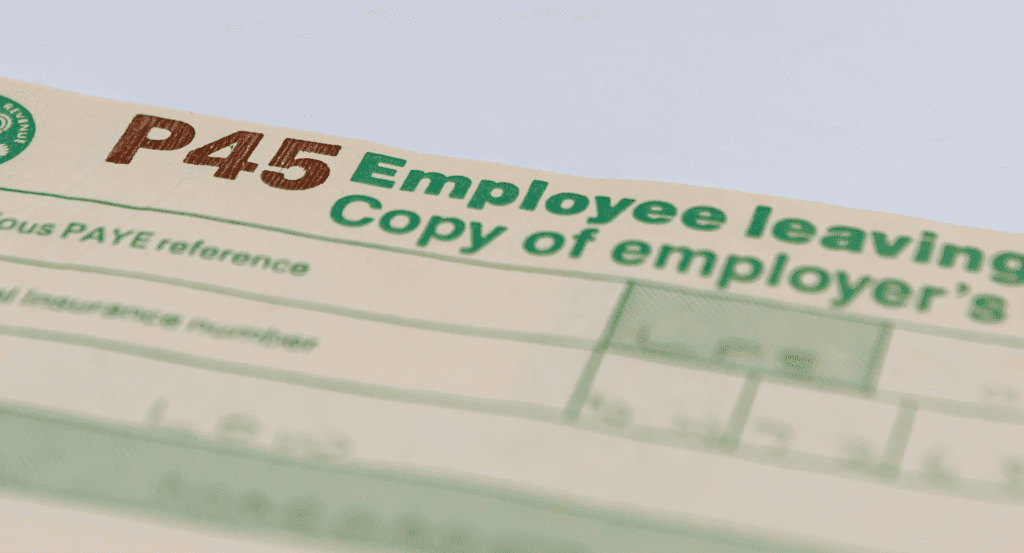What is a P45? A Working Guide

When you start a new job, one of the documents you’ll be expected to provide is a P45. But what is a P45? It’s a document that includes all the information your new employer needs to ensure your taxes are paid properly.
No matter how you leave your previous job, your employer is obliged to provide you with a P45. It’s not a certificate of achievement or any sort of accolade. It’s simply a formal document to ensure you can pay your taxes correctly.
Even if you don’t intend to start a new role, you’ll need a P45 when you leave your job. If you haven’t received it by your last day, you should ask for it to be sent to you.
Read on to find out all about this crucial document that follows you throughout your working life.
What is a P45? And what is a P45 used for?
A P45 is a statement of all the income tax your employer has paid for you for the current tax year. It has helpful information for you and your new employer. The information on your P45 includes:
Your details. Your name, address, date of birth, and gender, as well as your PAYE reference, payroll (if applicable), and National Insurance numbers. Your gross pay. This is your complete wage before any tax has been taken off, up to the date you left your job.How much tax you’ve paid. Your employer will have already deducted tax for the year to date. Your P45 statement shows the exact amount they’ve paid for you.Your tax code. This is made up of several numbers and one or two letters. Every different tax code indicates the calculations your employer needs to make to deduct the right amount of tax from your wage.Your employer’s details. This includes their PAYE reference number and business details, and your payroll number, if there is one.
This information lets HMRC and your new employer know how much tax you’ve already paid and the rate of tax you’ll need to pay for the rest of the tax year. If you’re retiring instead of starting a new job, your pension provider will use this statement to calculate the tax on your pension payments.
The statement has four parts. Your employer lodges part 1 directly with HMRC and gives parts 1A, 2 and 3 to you. You should keep part 1A for your personal records and pass on parts 2 and 3 to your new employer.
Do I need a P45 to start a new job?
In most cases, yes, you’ll need to provide a P45 to start a new job. There are only a few instances in which you won’t need a P45 to begin working in a new role.
Your first job. Of course, if this is your very first job, you won’t have a P45 because it’s the start of your working career and you won’t have paid any tax yet. Instead, you’ll be asked to complete the HMRC’s starter checklist. This provides all the information needed to assign you the correct tax code.
Taking an extra job. Because a P45 is only generated when you finish working with an employer, if you’re taking on a second role — a part-time job to help save for a holiday or home for instance — you won’t have a P45. Your employer won’t need to give you one either.
Instead, you’ll need to tell your new employer about your current job, any benefits you get, and if you’re still paying off a student loan. They may ask you to complete the HMRC’s starter checklist and you may be assigned a new tax code.
You’re moving from being self-employed to being employed by someone else. Tax works a little differently for people who are self-employed or run their own businesses. In this instance, there is no P45 to be issued.
If you’re moving from being self-employed, you’ll need to pay any taxes that are owed. Then, complete the HMRC’s starter checklist for your new employer. They’ll be able to assign you a new tax code and you’ll be set to start earning and getting paid by them.
You’re unable to get your P45 from your previous employer. Maybe your employer went out of business, or you lost your P45 and they’re refusing to provide a replacement. In this instance, they’re breaking the law. You can, and should, report them to the HMRC. Being issued a P45 when you finish a job is one of your worker rights.
In the meantime, to keep the processes for your new job moving ahead, you may be asked to fill out the HMRC’s starter checklist. This will help your new employer give you the right tax code. Alternatively, you may be issued an emergency tax code while the issue is resolved.
How do I get my P45 and why should I bother?
In most cases, when your employment comes to an end, you’ll automatically be given a P45. If you’re not, you should ask for one. You are within your rights to do so — even if you have already left your job. Employers are obliged to provide a statement of all your pay and taxes when you finish working for them.
You’re P45 is an important statement that helps to ensure you’re paid correctly in your new role. Without it, you may end up paying more tax than you need to while your new employer figures out the right tax code for you. In simple terms, your P45 helps maintain continuity for your tax payments. It smooths the transition from one employer to another.
What is the difference between a P45 and a P60?
A P60 is the statement of your earnings and the tax paid for a complete tax year. It is provided by your employer for the last tax year, from April 6th to April 5th. Your employer must provide a P60 every year. And they must provide it either on paper or electronically by the end of May.
A P45 is a statement of the tax paid in an incomplete tax year. It includes everything that has been deducted from your pay to date for the current tax year. That will be from April 6th to whatever date your employment ends..
Both the P60 and the P45 are important statements. You should make sure you receive these at the appropriate times and check they are correct. It will tell you if you have paid too much tax or not enough. If you notice you have paid too much tax on the P60, you can claim this back. If you notice too much tax has been paid on your P45, this can be corrected with the assignment of your tax code for the new role.
You can find out more about the difference between a P45 and a P60 here.
Is a P11D different to a P60 or P45?
Yes. A P11D is used by your employer to tell HMRC about any employment benefits you get. This includes things like a company car, some childcare benefits, or bonuses. Because they make up some of your pay, you need to pay tax for them.
Most people never see a P11D. If you don’t work in HR or payroll and your employer deducts the tax you owe for your benefits from your pay, there’s no reason for you to be issued this at the end of your job or periodically. If you’re given a P11D, your employer will include a letter explaining how it works.
Quickfire summary: What is a P45?
A P45 is a document that details all the income tax your employer has paid for you for the current tax year. You’ll need it when you move from one job to another, as it will help your HMRC and your new employer work out the rate of tax you’ll need to pay for the rest of the tax year.
Your previous employer has to provide you with a P45 when you leave. If they don’t, you should report them to HMRC.
Also read:




